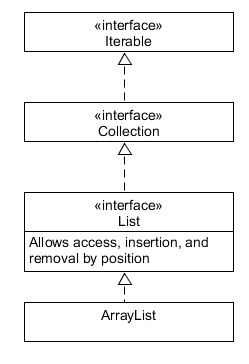ArrayList, Collection,
ConcurrentSkipListSet, HashSet, Iterable, LinkedHashSet, LinkedList,
List, PriorityQueue, Queue, Set, SortedSet, Stack, and TreeSet.
These are the main ones; we skipped most of the concurrent/blocking
structures, and some special-purpose ones. Note that the map ADT
(AbstractMap, TreeMap, and HashMap) aren’t connected to the others:
they form their own hierarchy that is so close to that for Sets, that
it isn't worth you writing (although we expect you to know and use
Maps). Hints: 1. Most relationships are that of an
interface extending or a class implementing an interface - use
dotted lines there. There is only one example of inheritance -
use a solid arrow there. 2. A class may implement multiple interfaces -
there is one example of that here. 3. Here is the top of the hierarchy
- copy this pic and skim each of these interfaces and class
in the javadoc to get started. 4. I just started with the ArrayList
javadoc and looked for the required classes/interfaces (finding
Iterable, Collection, and List), and then looked at each of
those
to see which one was a subinterface and which was a superinterface. 5.
Feel free to do this with a partner, but you must each submit one
copy.

- T1(N) + T2(N) = O(F(N))
- T1(N) - T2(N) = O(F(N))
- T1(N) / T2(N) = O(1)
- T1(N) = O(T2(N))
- Is it true that log2(n) is θ(log10(n))? Justify your answer. (Hint: use one of the logarithm formulas!)
- Is it true that 10n is θ(2n)? Justify your answer.
-
for (int i=0; i <= n+2; i++) {
for (int j=0; j < n * n; j++) {
sum++;
}
} -
for (int i=0; i < n; i++) {
for (int j=i; j < n; j++) {
sum++;
}
} - You may assume that n is a power of 2.
for (int i = n; i > 0; i /= 2) {
for (int j = 0; j < i; j++) {
sum++;
}
} -
for (int i=n; i >= 1; i = i / 2) {
sum++;
}
(10 points) Sometimes we give you an algorithm to solve a problem and you figure out how to make it happen in code. This, however, is your first "algorithm design" homework problem of the quarter:
You have a sorted array a of increasing integers. Give an efficient algorithm
that returns true if and only if an integer i exists such that
a[i]=i.
What is the running time of your algorithm?
You may assume that the array has no duplicate entries,
and therefore is strictly increasing. I.e. a[j-1] < a[j] for all j
with 0 < j < a.length. You may
not assume that all of the integers
in the array are non-negative, because then the problem would be
boring.
Show your algorithm (either a Java method or pseudo-code) and the results of your analysis. Obviously you should try to come up with an efficient algorithm; most of the credit for this problem will be based on your algorithm's efficiency. (Think about it carefully—is O(N) "efficient" for this task? Anyone can write a loop from 0 to a.length.)
Hint: while your goal is to produce pseudocode, algorithm design usually starts with sketching out some small examples and testing informal algorithm ideas on them, modifying them as needed, until you get something that works. For your small example, you could pick a small array of 7 ints, starting with a few negative numbers and increasing from there. Above them, write the indices 0,1,2,3,4,5,6 so you can see how a[i] compares with i. You may want to tweak your first example so that the method would return true, for example, let a[5]=5.